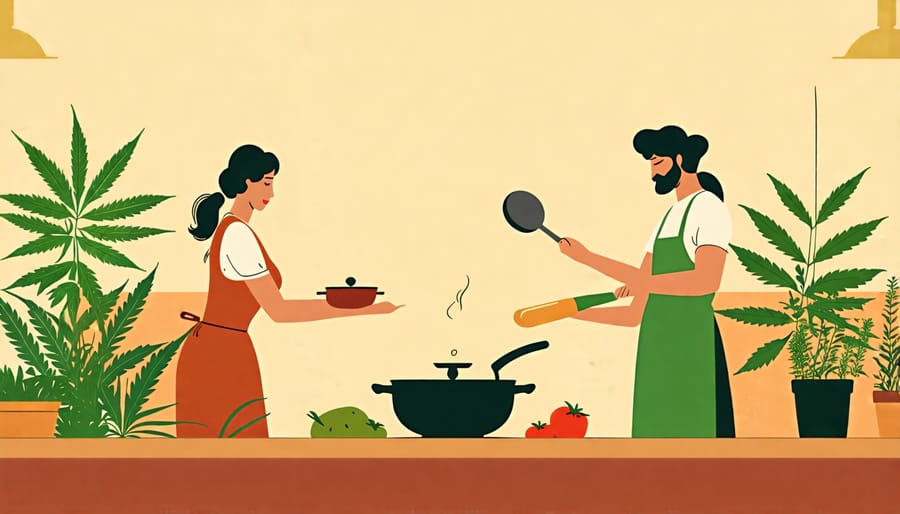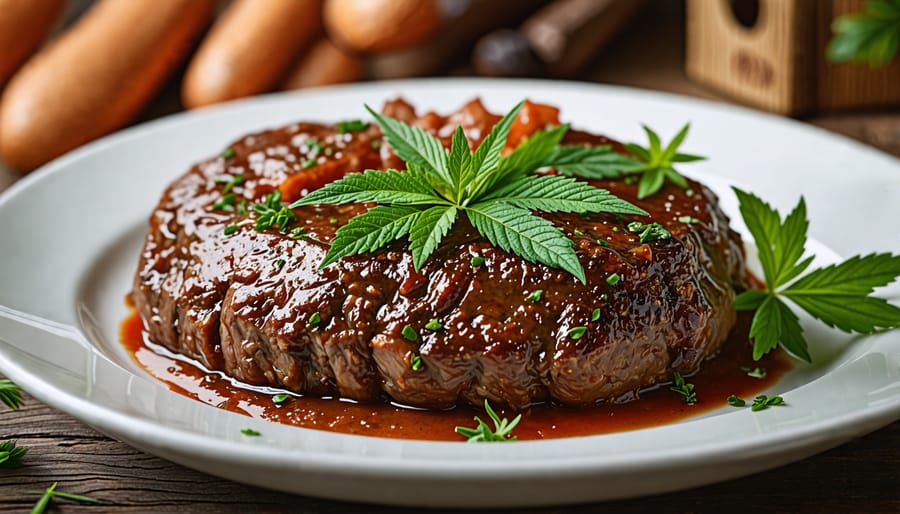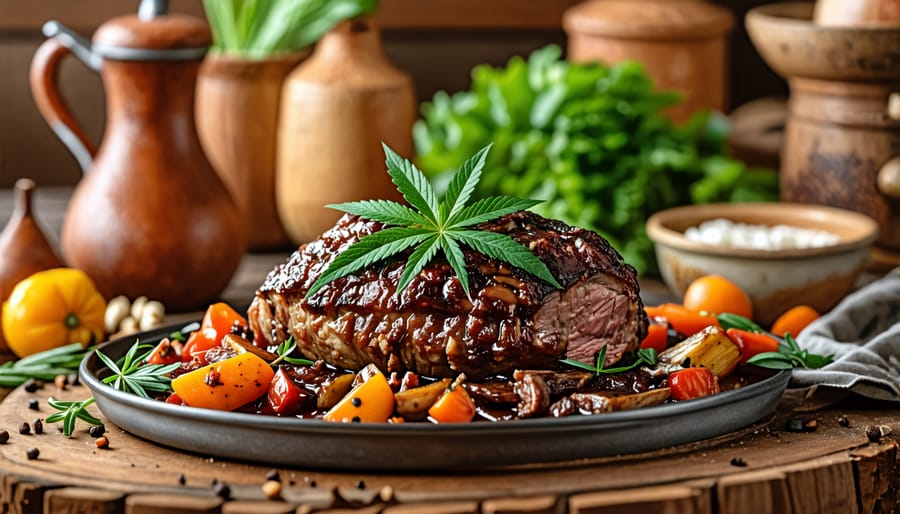How THC Flower is Revolutionizing German Cuisine: A Culinary Adventure
Infuse your next German dish with a unique twist by incorporating THC flower for elevated flavor and experience. Begin by selecting the strongest thca flower available to ensure potency. Grind the flower finely, ensuring an even distribution, and decarboxylate it in the oven to activate its psychoactive properties. Integrate this decarboxylated flower into classic German dishes, such as sauerbraten or bratwurst, by infusing it into fats like butter or oil—perfect for adding depth to savory flavors. For those with a sweet tooth, craft an indulgent Black Forest cake, subtly incorporating the flower into the cream for a sophisticated touch. Remember, moderation is key, so carefully dose to balance the rich tastes of German cuisine with the distinctive depth THC provides. Each culinary adventure promises an authentic experience brimming with cultural tradition, innovation, and a gentle nod to modern culinary trends.
Historical Context: Cannabis in German Culinary Culture
The intertwining of cannabis with culinary traditions predates the modern era, weaving a rich tapestry within German culinary culture. Historically, cannabis was utilized in folk remedies and domestic concoctions, its seeds often appearing in traditional dishes. During medieval times, cannabis seeds and hemp oil were common, valued for their nutritional benefits in rural German diets. The hearty hemp porridge, known as “Hanfgrütze,” was a staple in many households, providing sustenance in harsh climatic conditions.
As years progressed, cannabis faded into obscurity within culinary practices, overshadowed by stringent regulations and the rise of other prominent ingredients. Yet, with the burgeoning interest in traditional foods and the recent wave of cannabis legalization trends, there’s a noticeable revival. Contemporary chefs in Germany are rekindling interest in this ancient ingredient, experimenting with its nutty flavor and subtle, aromatic qualities. Envision cannabis-infused spaetzle or invigorating hemp-seed bread, delicacies offering new adventures for taste buds keen on exploration.
Attitudes are indeed shifting, with a growing openness to experimenting with cannabis in the kitchen. This cultural comeback is embraced by many chefs committed to reviving heritage ingredients with modern flair. Interviews with local chefs shed light on the enthusiasm surrounding cannabis, symbolizing a fascinating fusion of past traditions and future culinary innovations. For those eager to dive deeper into the expanding world of German dishes, exploring the esteemed culinary landscape offers an exciting avenue for experiencing authentic flavors and history. Discover more about this rich tapestry of flavors in our German culinary culture.

Incorporating THC Flower into German Recipes
Enhancing Flavors and Aromas
In the realm of German cuisine, enhancing the flavors and aromas of dishes is an art form, with every plate a potential masterpiece. Introducing THC flower to traditional recipes like Sauerbraten or Bratwurst offers a unique twist that can intrigue the palate and elevate the sensory experience. This aromatic flower infuses dishes with a subtle earthiness that complements the rich, hearty characteristics typical of German gastronomy. Imagine savoring Sauerbraten, the tender pot roast, transformed by the nuanced flavors of THC, which amplify the spices and deepen the tangy sweetness of the signature marinade. Likewise, in a freshly grilled Bratwurst, THC flower can introduce an unexpected layer of flavor, weaving seamlessly with the savory spices and adding an aromatic depth to each bite. Speaking with chefs keen on innovation, you’ll find that the key lies in balance, ensuring THC’s presence enhances rather than overwhelms, allowing diners to explore a new frontier in a mannered fusion of tradition and modernity.

Balancing THC Effects in Cooking
To achieve a harmonious balance when incorporating THC flower into German recipes, it’s crucial to meld the herb’s potency with the culinary integrity that defines these traditional dishes. Start by understanding that the goal is enhancing the meal, not overwhelming it. Dosage plays a key role: begin with small, carefully measured amounts of decarboxylated THC flower. This allows both newcomers and seasoned enthusiasts to enjoy the experience without sacrificing flavor or tradition.
Consider pairing THC with rich German ingredients like succulent bratwurst or hearty pretzels, where the earthy notes of cannabis can complement the robust flavors. A touch of THC-infused butter in a vibrant Kartoffelsalat (potato salad), for instance, can elevate the dish if used sparingly. Steeping THC flower in oils or butters creates a subtle infusion, imparting an extra layer of depth to age-old recipes without overshadowing the dish’s essence.
Lastly, always prioritize the enjoyment of your guests. A well-balanced THC-infused dish should enhance conversation and connection, much like a good glass of Riesling. By respecting both the power of THC and the cultural integrity of German cuisine, you cultivate not just a meal, but a memorable experience.
Popular German-Inspired THC Dishes
THC-Infused Pretzels and Sausages
In the heart of German cuisine, the combination of pretzels and sausages holds a revered place. Adding a modern twist, THC-infused versions of these delicacies are emerging as an exciting culinary frontier. Imagine biting into a perfectly chewy, golden-brown pretzel, each knot delicately dusted with a hint of THC-infused salt that enhances its earthy undertones. These pretzels are not only an innovative snack but also a harmonious blend of tradition and contemporary cuisine, captivating adventurous palates.
Sausages, a staple of German gastronomy, have also joined this trend, with THC being infused directly into the meat mixture. This process not only imparts the distinct flavors of the flower but also preserves the sausages’ savory and smoky goodness. An immersive experience awaits as these sausages are grilled to perfection, offering a novel taste while paying homage to time-honored recipes.
In bustling Berlin or trendy Toronto, these THC-infused delights are gaining popularity among enthusiasts seeking authentic and memorable culinary experiences. Celebrated chefs across the globe are experimenting with these innovative infusions, blending cultural authenticity with a modern twist, making the THC-infused pretzels and sausages both a tribute to tradition and a step into the future.

Baking with THC: Traditional German Pastries
Diving into the world of traditional German pastries with a modern twist, THC flower is seeing intriguing applications in the realm of German baking. From the fragrant dampfnudel to the rich and spicy lebkuchen, infusing these age-old recipes with THC introduces an innovative culinary experience for enthusiasts seeking something beyond the ordinary. Whether used in a warm, custard-filled buchteln or crispy Berliner, THC flower can complement the deep, hearty flavors of German desserts. Imagine savoring the buttery, almond-laden layers of a bienenstich cake while enjoying enhanced relaxing effects.
Adding THC flower to German pastries not only elevates the flavor profiles but also offers a creative way to experience the therapeutic benefits associated with cannabis. However, achieving the perfect balance in potency and taste requires attention and precision in the baking process. For those keen to explore more about German baking, incorporating cannabis opens up new, playful pathways that marry tradition with modern culinary art. As stories of cannabis-infused schnecken and gugelhopf weave their way through kitchen lore, the intersection of ancient customs and contemporary ingredients becomes a fascinating journey.
Legalities and Safety Considerations
When exploring the culinary use of THC flower in Germany and Canada, it’s essential to consider both legalities and safety aspects. In Germany, the use of THC flower in cooking is tightly regulated and primarily restricted for medicinal purposes. As cannabis is classified as a controlled substance, individuals looking to incorporate it into German recipes must have a prescription. This legal framework aims to ensure that its use is both safe and medically supervised. Travelers and food enthusiasts should be mindful of these regulations to avoid legal complications and respect local laws.
In Canada, the landscape is more permissive following the legalization of recreational cannabis. This has opened the door to innovative culinary experiments, allowing individuals to incorporate THC flower into various dishes creatively. However, it remains crucial to adhere to safety guidelines. For instance, knowing the proper dosages is key to avoiding adverse effects. It’s advisable to start with small amounts and gradually adjust based on personal tolerance. Understanding how THC is metabolized can also enhance culinary experiences, as edibles process differently in the body compared to smoking.
Safety goes hand-in-hand with responsible consumption. Whether in Germany or Canada, individuals are encouraged to cultivate a respectful approach to using THC in cooking. Chefs and home cooks alike can find inspiration in blending traditional flavors with new ingredients, all while ensuring a safe and enjoyable dining experience. As cultural curiosity engages culinary enthusiasts globally, adhering to these guidelines fosters mindfulness and creativity in every THC-infused dish.
Conclusion: The Future of THC in German Cuisine
As THC flower begins to sprinkle its enigmatic charm over the landscape of German cuisine, it offers a unique twist to the traditional culinary practices we know and love. Today, an increasing number of adventurous chefs, intrigued by the plant’s potential, are experimenting with THC-infused dishes, crafting experiences that tantalize the senses while honoring Germany’s rich gastronomic heritage. From delicate THC-infused sauces complementing hearty Bratwurst to subtly tinged baked goods that bring a new dimension to Kaffee und Kuchen (coffee and cake), the possibilities are as boundless as the creativity of those wielding the whisk.
Looking ahead, the trend of incorporating THC into culinary delights is poised to grow, driven by an evolving understanding of both the culinary and sensory possibilities it offers. Chef Johannes, an innovator in Berlin’s culinary scene, shares a vision where responsible integration of THC accentuates flavors and textures, paving the way for unforgettable dining experiences. As the culinary landscape broadens, THC flower in German cuisine looks set to redefining traditional flavors while offering new stories to the global gastronomic tapestry.

